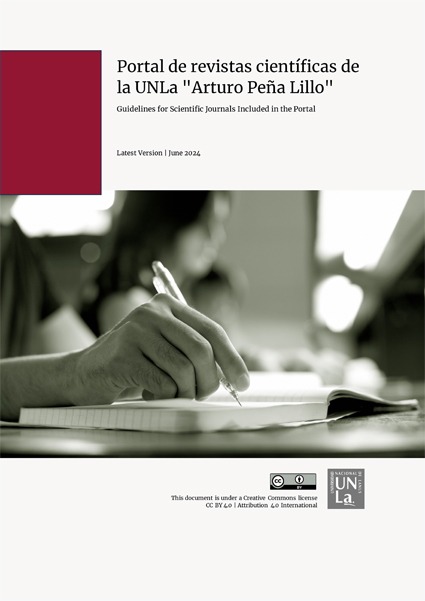General guidelines
 Photo: Diego Cervo | Last update | June 2024
Photo: Diego Cervo | Last update | June 2024
Generals guidelines
Definition of a Scientific Journal
Editorial Boards
Instructions for Authors
Online ISSN
Persistent Identifiers
Generals guidelines
All definitions and policies adopted on this portal are part of the document «Guidelines for scientific journals that are part of the UNLa Scientific Journals Portal "Arturo Peña Lillo"», approved by the Superior Council of the National University of Lanús, and agreed upon by the editorial boards of the journals that make up the portal.

Guidelines for scientific journals that are part of the UNLa Scientific Journals Portal "Arturo Peña Lillo"
Última actualización | junio 2024
Definition of a Scientific Journal
According to Latindex Criteria, a scientific journal is a periodical publication that releases new content continuously within the declared periodicity of the journal itself. It publishes at least 40% of original research articles, review articles, essays, technical notes, book reviews, among other formats, which contribute to the journal's area of knowledge. It is encouraged that at least 50% of the published works come from authors external to the publishing entity and its editorial bodies. Scientific journals are distinguished by implementing an external peer review system (double-blind, single-blind, or open review) that ensures the scientific quality of their content.
Editorial Boards
Each journal has its own editorial board composed of researchers related to the journal's thematic area. The full names, institutional affiliations, and countries of the individuals comprising the editorial board (responsible editor, editorial committee, editorial board, or other designations) are explicitly stated. "Editorial openness" is promoted, meaning that at least two-thirds of the members of the editorial boards belong to institutions different from the publishing entity.
Instructions for Authors
Each journal prepares and makes available on its website the criteria for text presentation, submission methods, sections open for submission, text length according to each section, characteristics of the abstract (structured or unstructured), the thesauri chosen for the selection of keywords, the formats for presenting graphics and figures, as well as the bibliographic reference system that best fits the usual practices of its area of knowledge (Vancouver, Harvard, APA, etc.).
Online ISSN
Each journal has an ISSN for the electronic version, issued by the National ISSN Center and validated by the International ISSN Center, which is published on the homepage of its website.
Persistent Identifiers
Scientific journals that are part of the portal have access to the implementation of the Digital Object Identifier (DOI), through the membership financed by the National University of Lanús to Crossref. The DOI is a unique code for identifying digital objects such as scientific articles. It allows the interoperability of each record's metadata between different information systems, enriching and expanding the distribution of content and the use of alternative metrics for the usage and citation of published content.
Additionally, journals that are part of the portal have access to the implementation of ORCID validation, a persistent digital identifier for researchers, created and managed by each researcher, which allows linking a persistent identification code with their professional information: affiliations, grants, publications, peer review, etc. ORCID allows sharing that personal academic information with other systems, ensuring recognition of all contributions, and reducing the risk of errors in authorship assignment.
Moreover, the portal provides the possibility for each journal to implement the Research Organization Registry (ROR), that is, the persistent identifier of institutional affiliations of the authors of the published articles.
INFORMATION | SUPPORT
POSTAL ADDRESS
- Secretaría de Investigación y Posgrado
- Universidad Nacional de Lanús
- 29 de Septiembre 3901, Lanús
- (B1826GLC) Buenos Aires, Argentina
ABOUT THE PORTAL
GENERAL GUIDELINES
EDITORIAL POLICIES
PUBLICATION ETHICS POLICIES
- Original and Unpublished
- Duplications
- Authorship
- Policy on Plagiarism, Self-Plagiarism, Duplication, and Fragmentation
- Correction and Retraction Policy
RESEARCH ETHICS POLICY

Portal de Revistas Científicas de la UNLa "Arturo Peña Lillo"
Publisher: Universidad Nacional de Lanús
Rector: Daniel Rodriguez Bozzani
29 de Septiembre 3901, Remedios de Escalada, Lanús (B1826GLC), Provincia de Buenos Aires, Argentina
